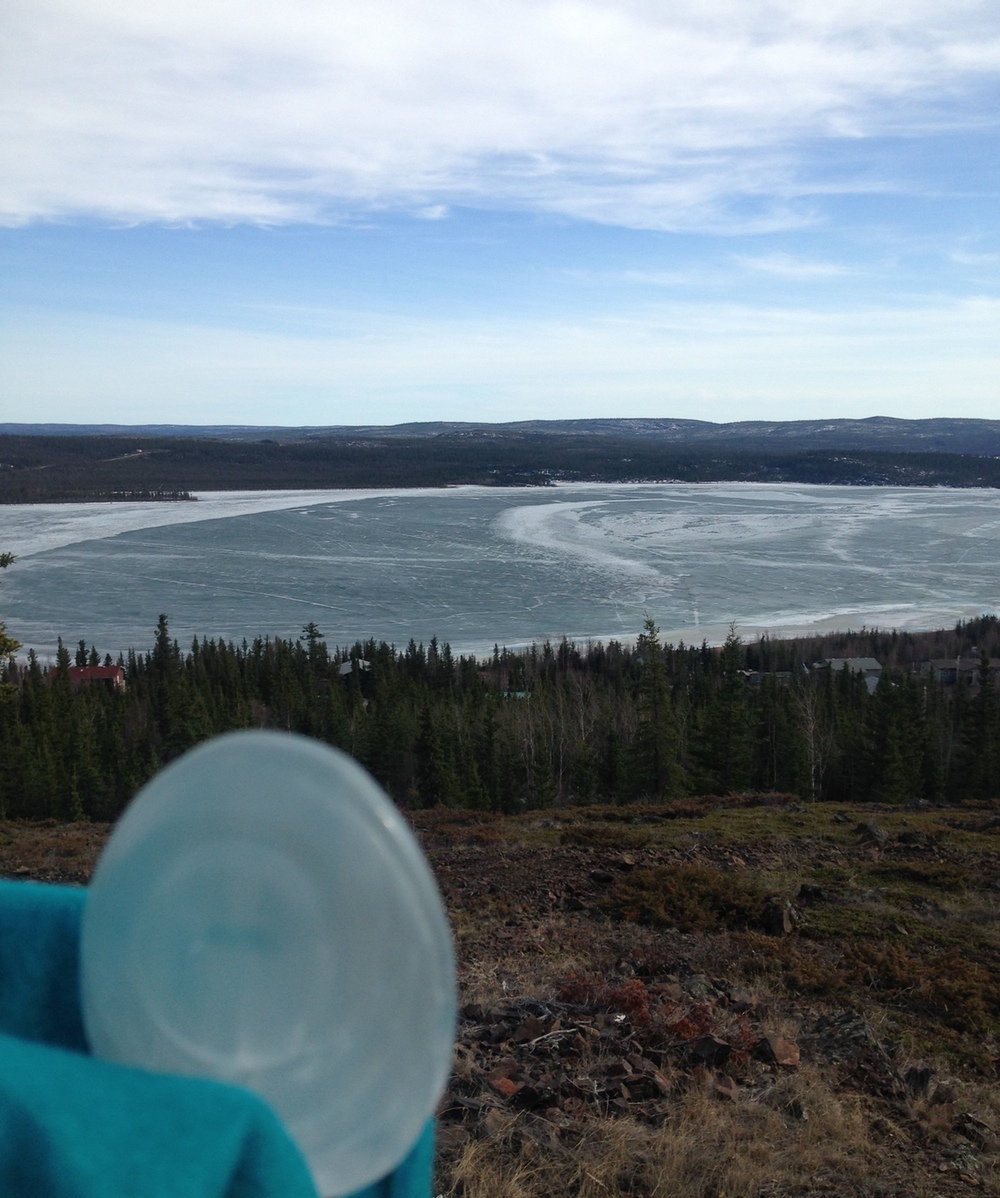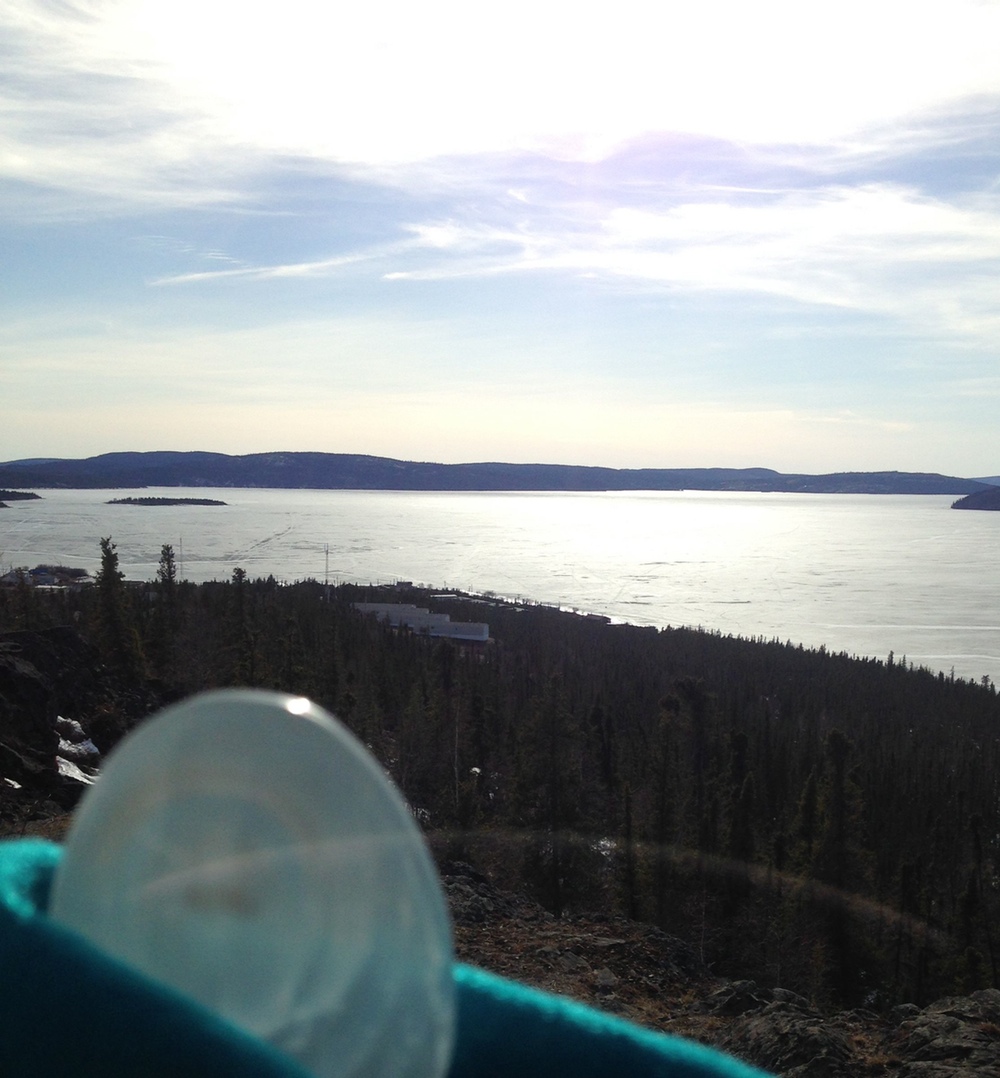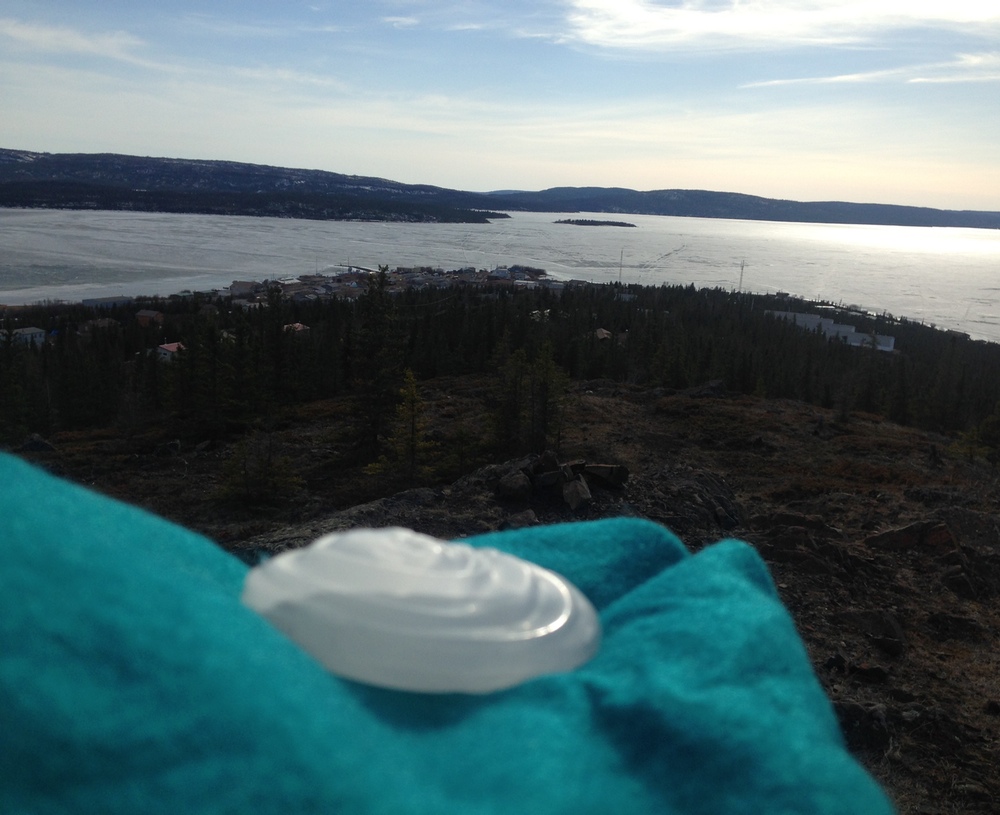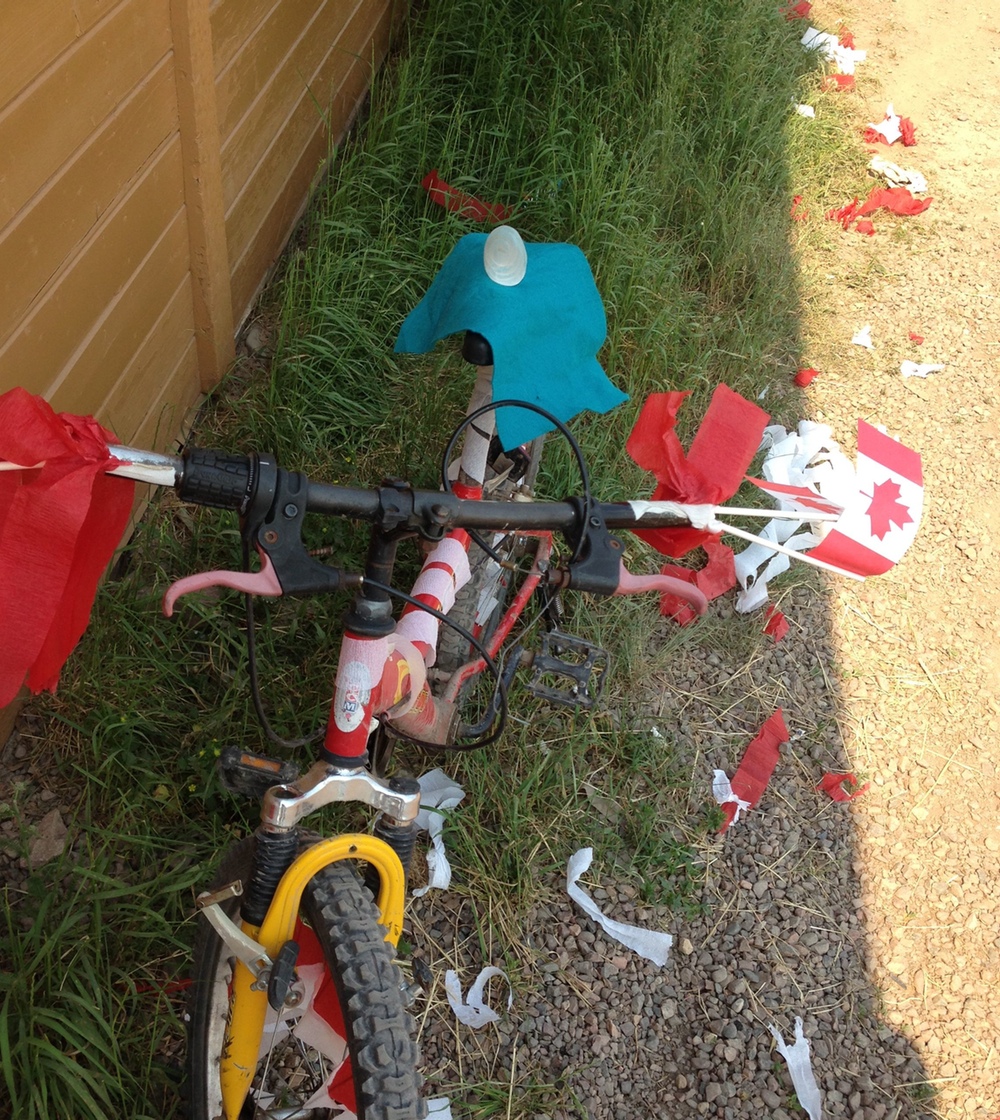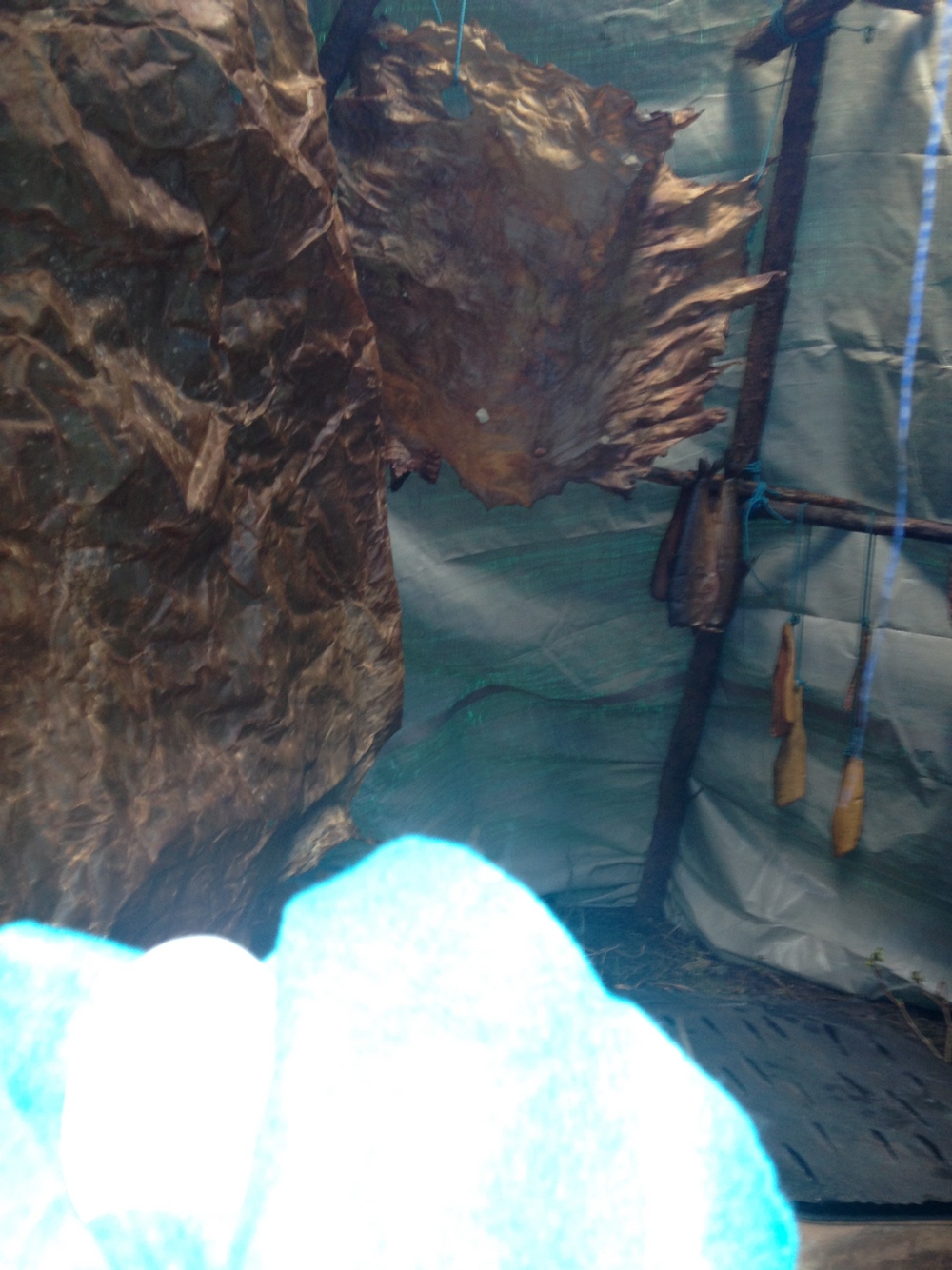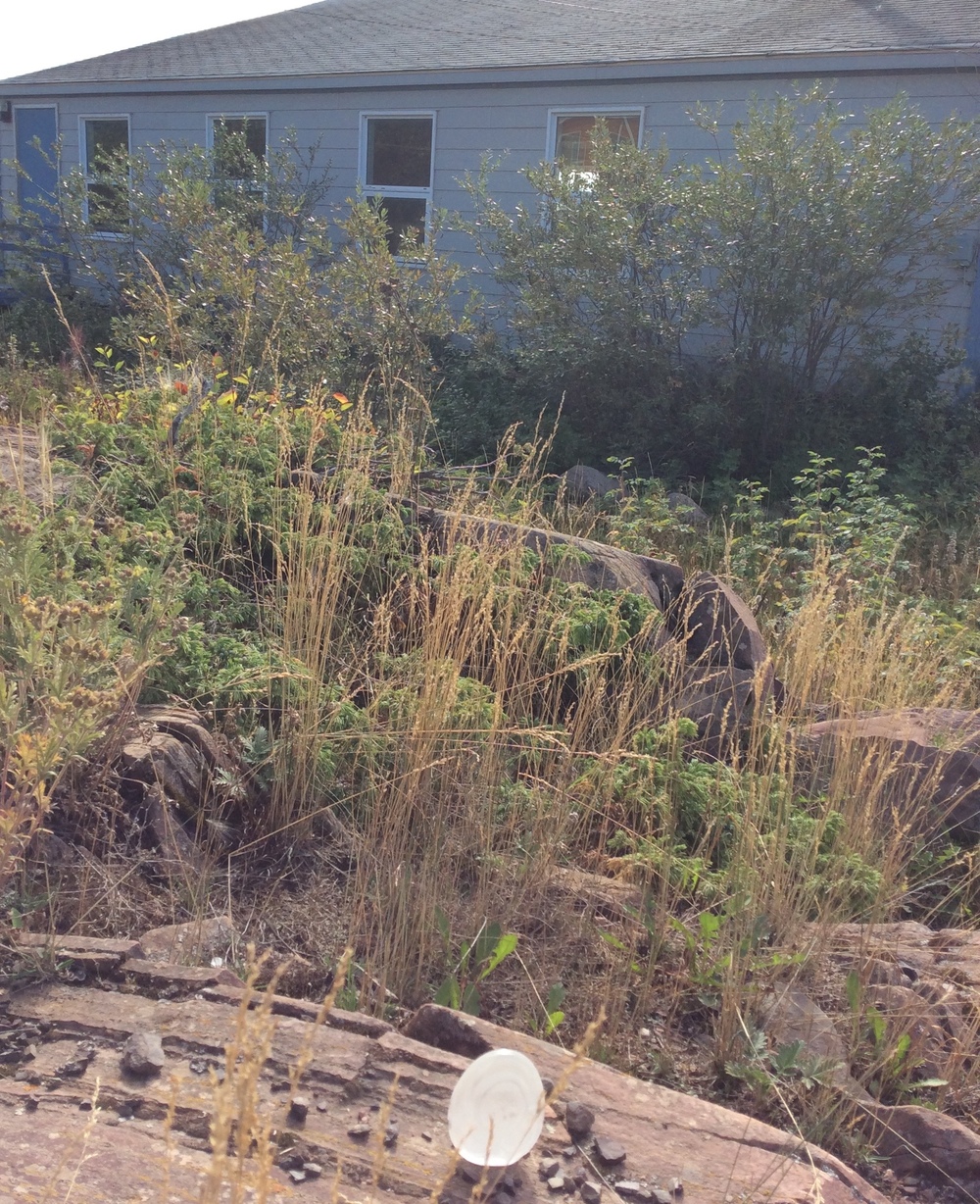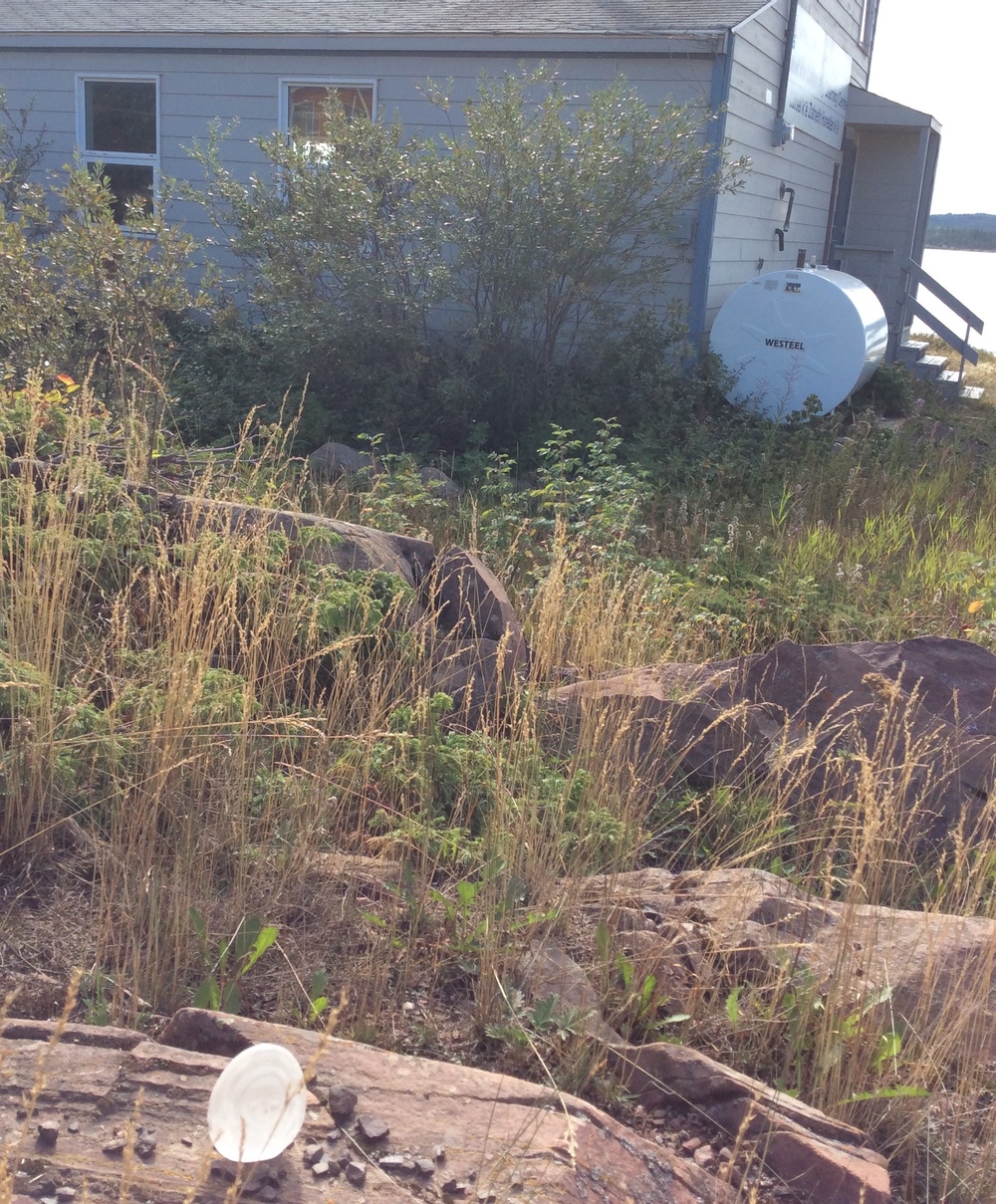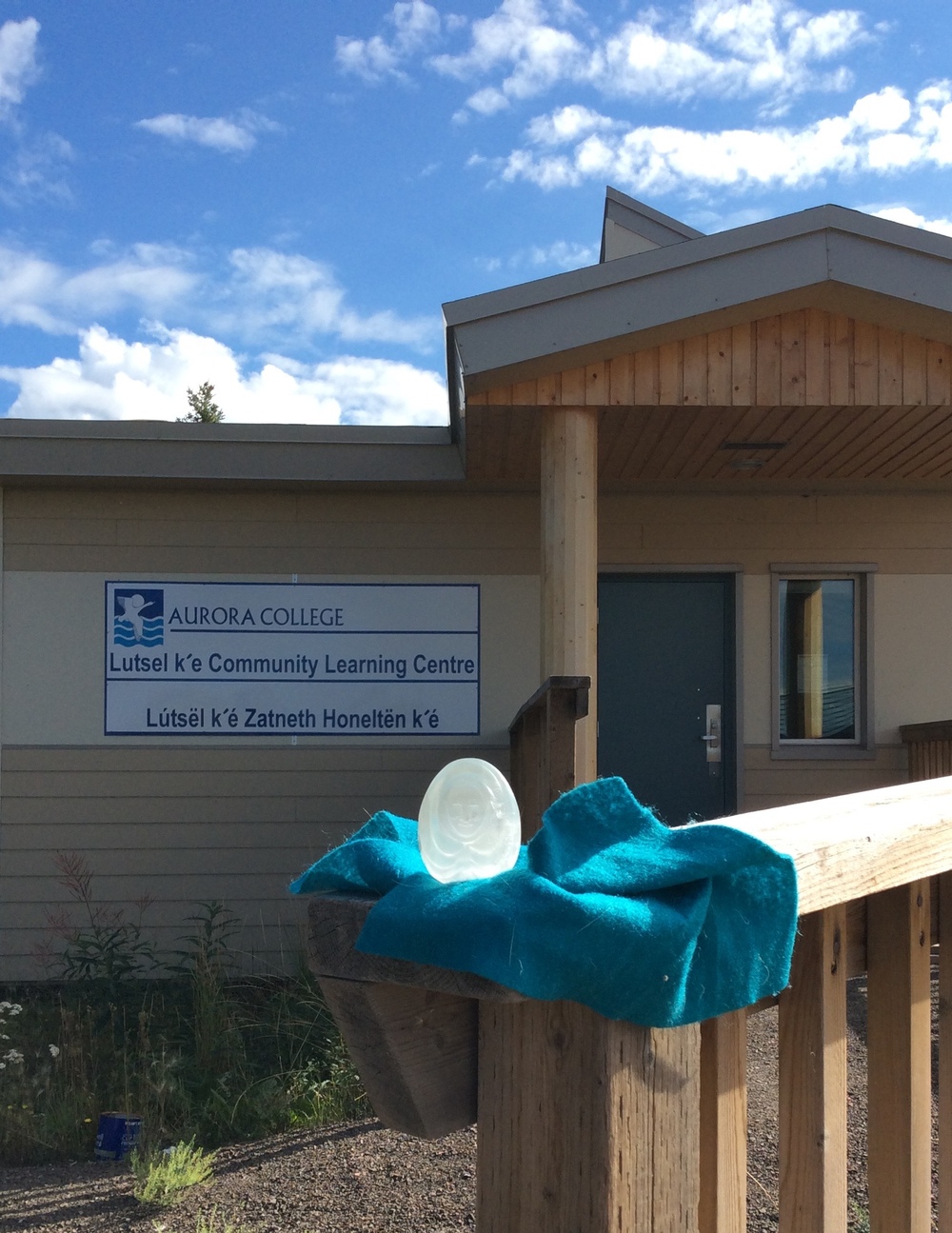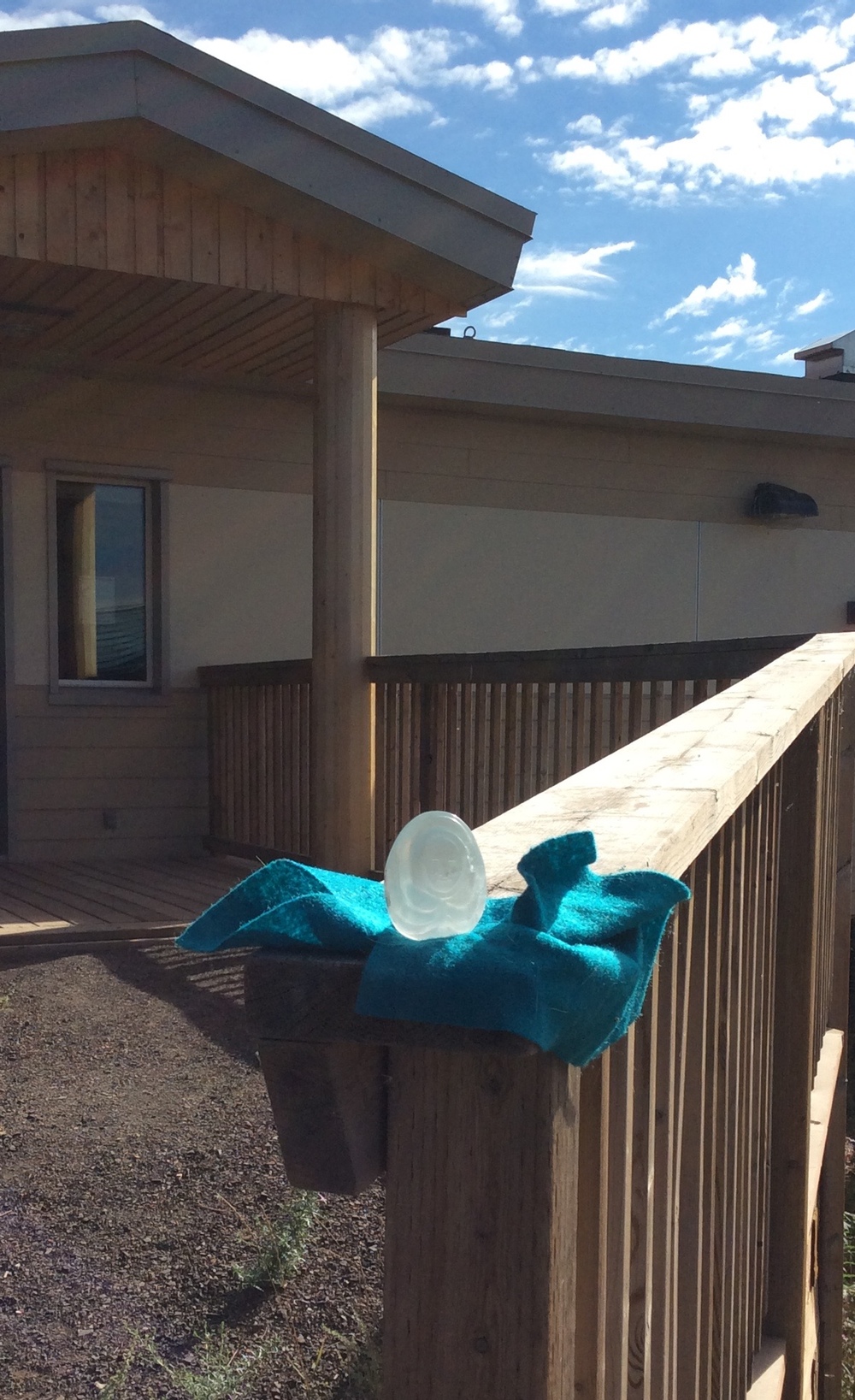Lutsel K'e First Nation Collaboration
Introduction: Northern Waterways YEG-GA and AC
Northern Waterways YEG-GA (far left) with friends, 2016
The carving known as "Northern Waterways YEG-GA" (see image, bottom left) began its travels with A.C. in Spring 2016, just before A.C. returned home to the Lutsel K'e Dene First Nation for the Summer. Northern Waterways YEG-GA was part of a select set of carvings undertaken for Project Y150 YEG-GA by the School One Carver which were derived from a "block" of Moroccan selenite acquired from the rock merchant Asad and his son on 118 Avenue, Edmonton, in early 2106. The piece was also directly related to another group of YEG-GA carvings made specifically for a "Learning Environment" exercise undertaken by a smart bunch of students enrolled in a History class at the University of Alberta. As explained elsewhere, the students in the course documented their own journeys with those "sister carvings" in the North Saskatchewan River Valley and then measured their River-Valley insights into continuity and change according to competing theories of "Creative Destruction" and the impact of different types of human activities upon the natural environment over time.
As the School of One quickly learned, A.C. is a gifted, enthusiastic student of History, Culture, and the Environment currently in the process of completing a degree in Native Studies at the University of Alberta. In regards to "Northern Waterways", for example, A.C. once explained to the School of One Carver how the Lutsel K'e Dene First Nation successully defended a sacred site known as "the Lady of the Falls" (Ts’akui Theda) on the Lockhart River from a hydroelectric expansion project. The carving called Northern Waterways YEG-GA is dedicated to the individual agency, accomplishments, contributions and collaborative efforts of mothers, daughters, and sisters, especially those of them who are dedicated to the preservation of the traditions of their ancestors in the Northwest Territories.
Links:
For further information about Lutsel K'e Dene First Nation, please see, Lutsel K'e First Nation
For brief summary of "LKDFN cultural issues" explaining opposition to the Taltson Hydroelectric Expansion Project, please see page 96, Mackenzie Valley Review Board Report
Marking Time and Delineating Place: Lutsel K'e Summer Landscape, 2016
The journeys of A.C. and Northern Waterways YEG-GA began when A.C. returned home from university for the Summer, 2016. The vignettes within the following "alternative micro history" document experiences, memories and key features of Lutsel K'e and provide unique insights into an extraordinary corner of the North with a seemingly endless horizon. The Summer 2016 collaborative vignettes from Lutsel K'e (which A.C. also called "[my] Summer Project") also marked an important turning point since at the end of the Summer A.C.'s nuclear family moved to Yellowknife.
A Little History According to the Cycles of Seasonal Light
Received June 23, 2016. Looks warm.
The town was established many years ago when the Hudson’s Bay Company opened a store and the people living in the surrounding area settled here in order to be closer to the establishment. The top of the hill overlooking the town is a place for a wonderful view all year round. Each season provides a different background to the town and during Autumn the leaves change colours from green to different hues of red orange and yellow. This dramatic seasonal change makes the town look more colorful. Winter brings white snow and ice, thus creating a beautfiful winter wonderland, especially with the combination of the artificial town lights and the natural Northern Lights filling the sky. Thanks to the melting snow during the early Spring (when this picture was taken), the town sprouts different shades of green even though the ice still lingers as a reminder of the months marking a cold Winter. During the Summer this place is so full of life, and, with a sun that never seems to sleep, the town is always basking in its glow. No matter the season this will always be home to the people who live here.
Canada Day Bikes and Quads on Parade
1 July, 2016. Weather seems good.
On Canada Day children decorate their bikes with the colors of the Canadian flag, and each bike is adorned differently with streamers, little paper Canadian flags and stickers, all in red and white. Some of the kids have a bigger Canadian flag attached to the back of their bikes. Meanwhile, adults prefer to decorate their quads but still utilize the red and white colors of the Canadian flag. A few years had some memorable and notable exceptions. One year there was a quad decorated with stuffed toy fish, antlers and a bingo card along with the requisite red streamers and the Canadian flag, while another quad sported a frying pan, a tea kettle, snowshoes, balloons, and the requisite red streamers and the Canadian flag. Once all of the quads and bikes are finished everyone gathers at the community hall and a short parade ensues. This way eveyone can show off their Canada Day creations throughout town before returning to the community hall where the best entries in the parade are given prizes.
Canada Day Canoe Race
1 July, 2016. Still warm.
During Canada Day one of the many events held in the community is a canoe race in which teams of two people race against time, and the team with the fastest time is given a prize. Teams of women race first, and then teams of men. Some of the other sporting events that are held on July 1 include bike races for the kids, an egg toss, a balloon bust, the shoe scramble, and, of course, the mandatory "egg-on-a-spoon" race. Recently, we have also started cake decorating contests, and, everybody’s favorite event, the fishing derby, as well as "the hand games tournament". Like the canoe races, prizes are given to the winners of each of these events, and all of them happen remarkably in one day. While it is really enjoyable competing for the prizes and watching other people race it is really great to participate just for the fun of it.
Hide Camp
Summer, 2016. Weather still seems good.
In recent years, the community of Lutsel K’e has started holding an annual Hide Camp just outside of the town near the mouth of the Snowdrift River. There, people pitch tents where they live for a week and learn how to tan hides from the Elders of the community. This year marked the Third Annual Hide Camp and the learning participants included students from the local community as well as students from Middle Hall School in Yellowknife. In the background of this photo we can make out some of the tents people lived in during the Hide Camp week, along with the picnic table where they ate and the fire pit used to cook their food. The Hide Camp on this special land is a great traditional learning experience for all of the participants.
Hide Tanning: Step 1
Summer, 2016.
Hide Tanning has been a part of the Chipewyan culture for a very long time but was not practiced for many years. In recent times, however, more people are willing to learn about the process of tanning moose and caribou hide. In the background of this image a group of people at the hide camp sit around a barrel covered in tarp with a moose hide in order to remove the hair from the hide by cutting it off, thus making it a very difficult process. An easier way to remove the hair would have been to let the hide soak in the water for a couple of days (or even a week or so), which makes the hair come off easier and you only have to peel it off the hide. If you leave the hide in the water too long the hide will rot and, as a result, it will be useless for tanning. Hair and fur removal constitutes the first of many steps in the process of tanning a hide, and there are several more steps that take place over the course of a couple of days. Furthermore, the process of tanning hides can take a long time, especially if you are doing it yourself.
Hide Tanning, Steps 2-4
Summer, 2016.
In this photo the moose hide has had its fur removed and it has been strung up and fleshed, meaning that all the meat and thick flesh of the moose has been scraped off. It takes a couple of hours for the hide to be fleshed and this crucial process has to be done as soon as the hide is strung up and is ready to be scraped. After the flesh has been stripped from the hide, the side where the fur was taken off has to be scraped in order to get rid of any thin hairs still remaining. The other side has to be scraped as well until the hide is a certain thickness (this is the stage that the hide is at in the picture). After all of these steps have been completed there are few others that follow, including soaking, stretching, and then smoking the hide for a couple of days before it can finally be called "done" and used for a variety of products.
Last Step: Smoking the Hide
Summer, 2016.
Here we see some of the caribou hides near completion in a dark teepee (explaining why in the images it is hard to see the face of the carving, even though it seems to glow in the venue). This step is undertaken after the hide has been scraped and soaked in a "brain mixture". After the soaking, the hide is stretched and then smoked using dried old rotten wood and moss. The smoke, like the mixture, soaks into the hide and turns it into a soft, tanned colour. The tanned hide is used to make moccasins, traditional clothing, vests, and other original sewn creations.
The Denesoline Corporation
Late Summer, 2016.
The Lutsel K’e Denesoline Corporation is a building located beside the Lutsel K’e Dene Band Office, near the waterfront of the Great Slave Lake. This summer the building was recently repainted. Before, it was blue and green and not just green as seen here. The Lutsel K’e Denesoline Corporation is not owned and run by the Chief and Council, but instead, is owned and run by the businesses residing inside the building, like the Wildlife Office. The Corporation is engaged in many different types of projects that include tourism, job training, and educational workshops. As a child it was always fun to run around inside the building since the middle part of the structure has a big meeting room surrounded by halls lined with offices.
The Elders' Residence
Late Summer, 2016.
The Elders' Residence is located beside the Lutsel K’e Dene Band Office and the Old Aurora College building by the Great Slave Lake. Inside the residence there are four apartments in which some of the elders in the community can live, while there are also other accomodations available for some of the other elders elsewhere in town. In the middle of the building there is a kitchen where the hired cook prepares food for the elders, and sometimes there is a "big meal event" in which all of the leaders of the community come and share a meal together in an open area just outside of the kitchen area. Occasionally, during the Christmas season, there is a celebration held in the Elders' Residence and some of the younger children of the community are invited to attend and a Santa Claus poses for pictures with the kids.
The Old Aurora College
Late Summer, 2016.
The old Aurora College is located beside the Elders' Residence, close to the shore of the Great Slave Lake. It was once used long ago to conduct classes that the college offered to the members of the community. Since the opening of the new Aurora College this building is used now mostly as a workshop. Inside, there are carpentry tools that the high school students sometimes use for a class. This year children in Grades 3-5 walked to this place from their school to witness one of the members of the community demonstrate and explain how to flesh a wolverine that was caught. Hence, while it is no longer used for College classes, this place still is a venue for learning,
Lutsel K'e Dene School
Late Summer, 2016.
The Lutsel K’e Dene School is located in front of the new Aurora College, near the Lutsel K’e Arena, and up a hill from the shoreline of the Great Slave Lake. The school began in the 1960’s and 1970’s, and, in recent years, witnessed the first-ever high school graduates. Before, the school used to be painted a yellow colour and had a different playground (with wood instead of the metal equipment introduced in the last decade). Now, the school is distinguished by its mostly brown exterior and largely has remained the same inside. Currently, the school is undergoing major renovations that are suppose to take up to two years to complete. The new changes to the school are something many people are looking forward to in the community, even with some recent complications adding problems to the renovations.
The New Aurora College
Late Summer, 2016.
The new Aurora College was built recently to replace the old one described earlier (the building located beside the Elders' Residence). This building is located behind the Lutsel K'e Dene School and near the Lutsel K’e Arena, quite a distance from the shoreline of the Great Slave Lake. Years before the new Aurora College was constructed there used to be a tree behind the site. As a child I would climb and play near the tree and during construction it was removed. I was a bit upset. Now, I know that this institution was built to provide a better space and place to teach the people in the community who want to acquire a quality education in order to get better jobs. That education should help them enhance the skills they need to succeed in those jobs. While the Lutsel K’e Dene School undergoes renovations, the new Aurora College will host the high school students so that they can still get their education to graduate and be able to attend post-secondary institutions.



